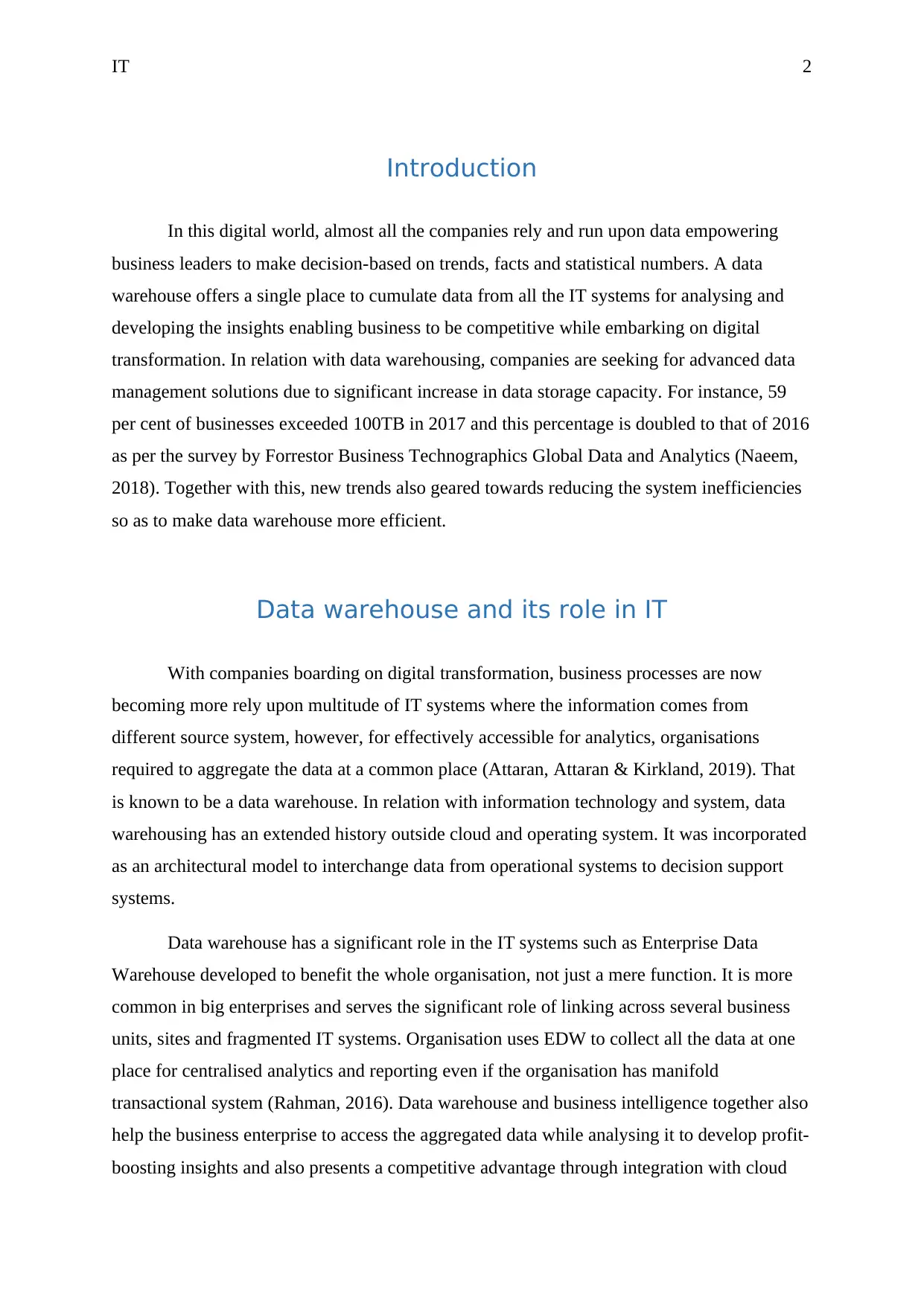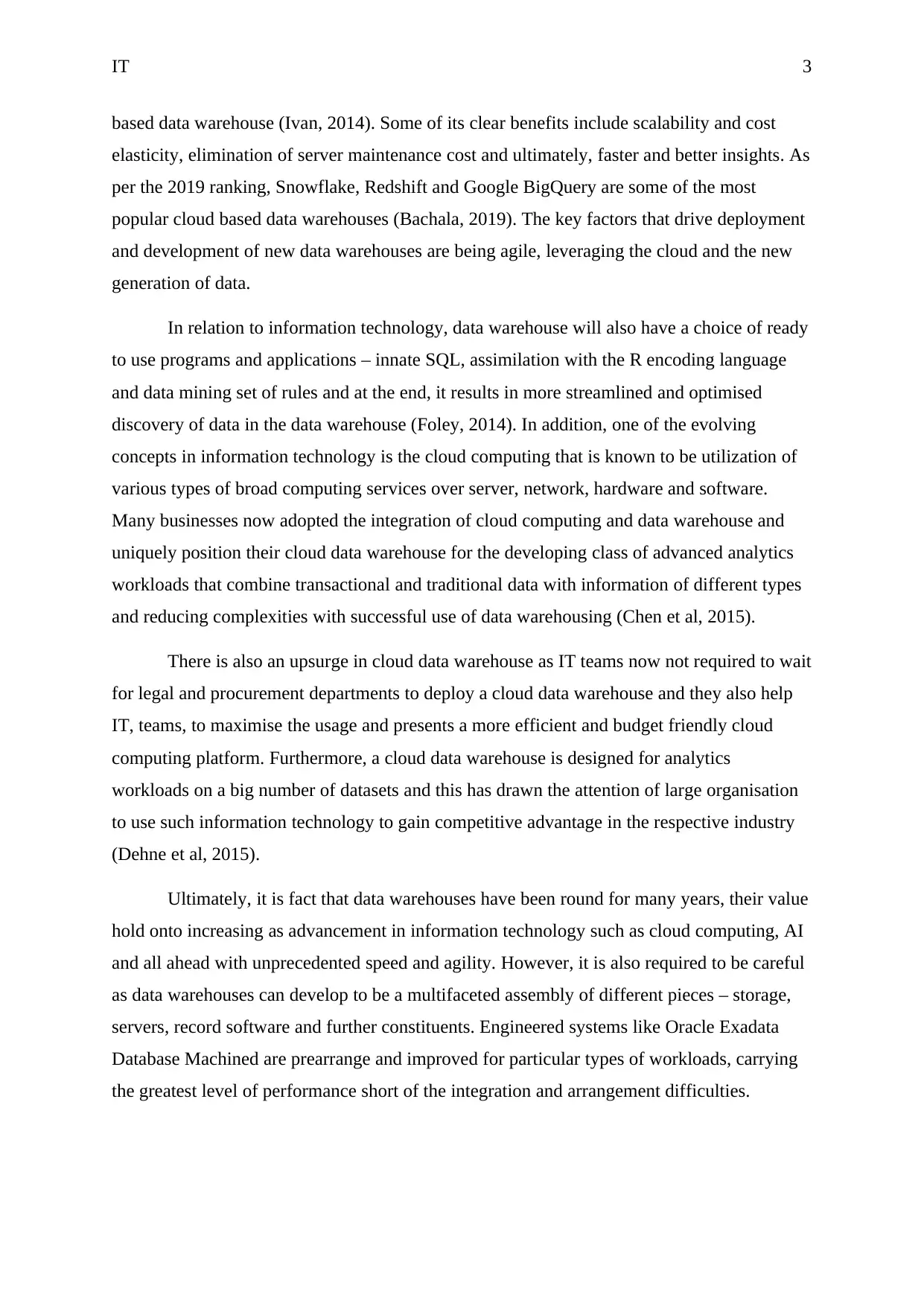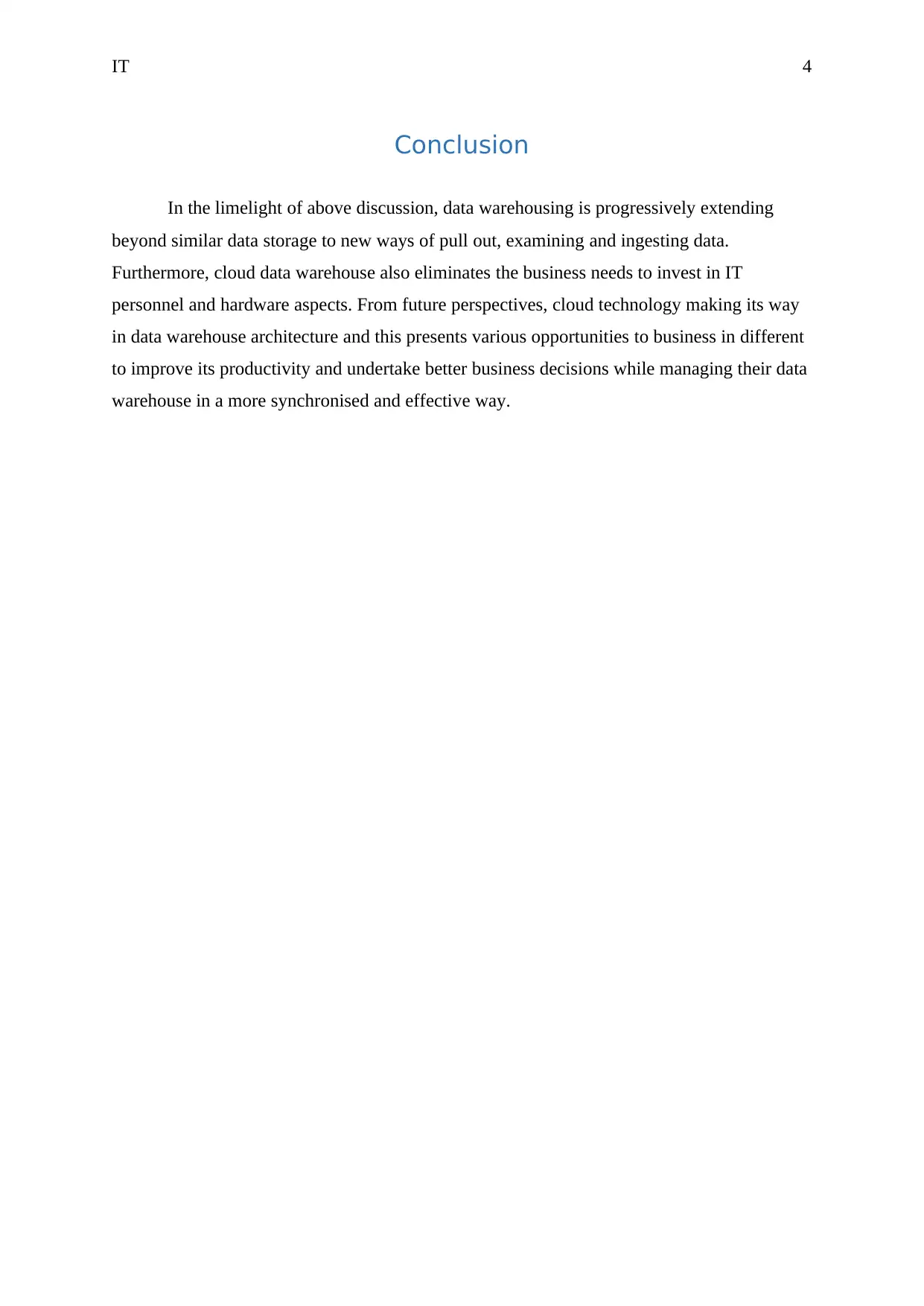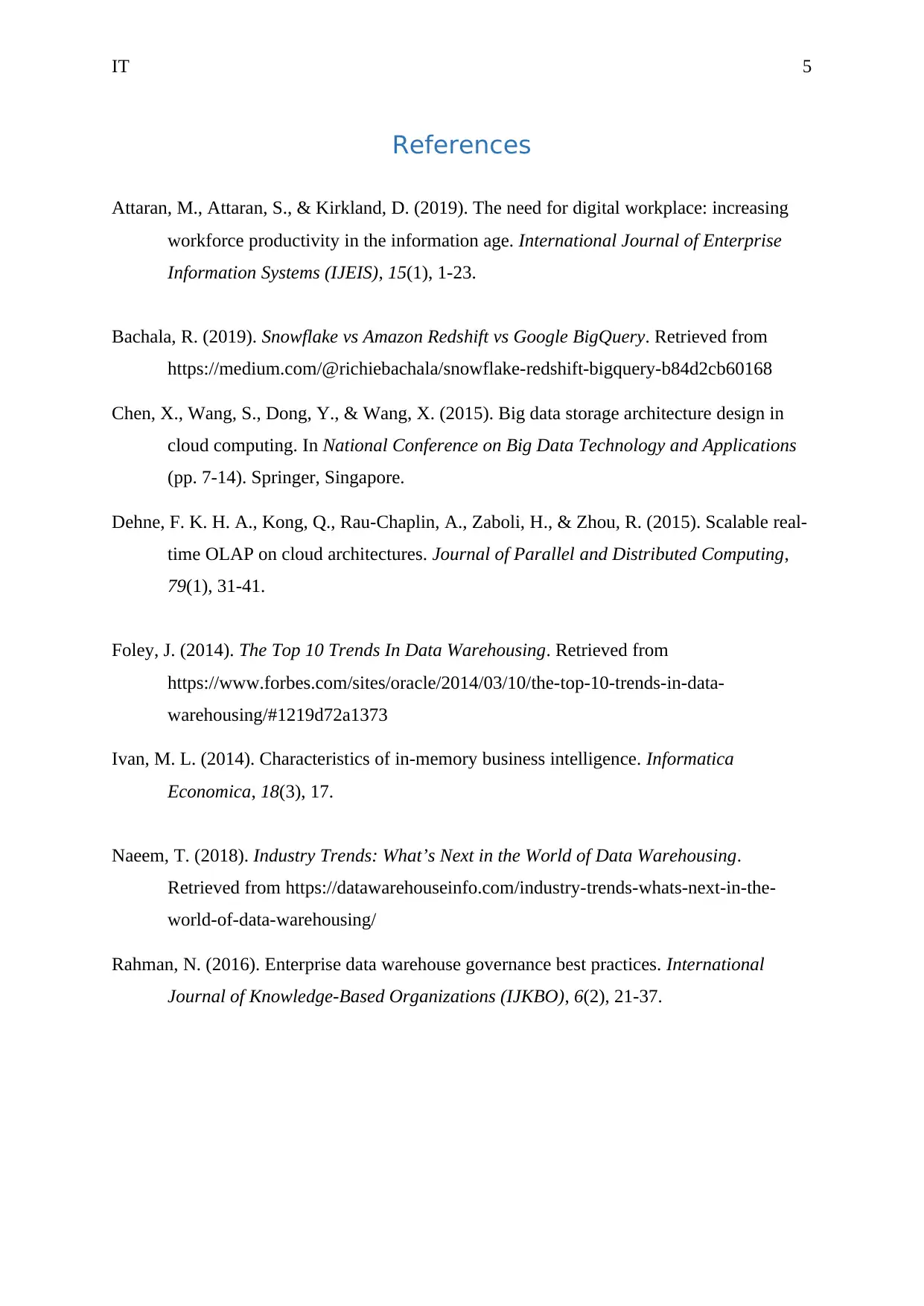Business Intelligence and Data Warehousing PDF
VerifiedAdded on 2022/08/21
|6
|1210
|24
AI Summary
Contribute Materials
Your contribution can guide someone’s learning journey. Share your
documents today.

Running Head: IT 0
Business Intelligence and Data Warehousing
Business Intelligence and Data Warehousing
Secure Best Marks with AI Grader
Need help grading? Try our AI Grader for instant feedback on your assignments.

IT 1
Table of Contents
Introduction................................................................................................................................2
Data warehouse and its role in IT..............................................................................................2
Conclusion..................................................................................................................................4
References..................................................................................................................................5
Table of Contents
Introduction................................................................................................................................2
Data warehouse and its role in IT..............................................................................................2
Conclusion..................................................................................................................................4
References..................................................................................................................................5

IT 2
Introduction
In this digital world, almost all the companies rely and run upon data empowering
business leaders to make decision-based on trends, facts and statistical numbers. A data
warehouse offers a single place to cumulate data from all the IT systems for analysing and
developing the insights enabling business to be competitive while embarking on digital
transformation. In relation with data warehousing, companies are seeking for advanced data
management solutions due to significant increase in data storage capacity. For instance, 59
per cent of businesses exceeded 100TB in 2017 and this percentage is doubled to that of 2016
as per the survey by Forrestor Business Technographics Global Data and Analytics (Naeem,
2018). Together with this, new trends also geared towards reducing the system inefficiencies
so as to make data warehouse more efficient.
Data warehouse and its role in IT
With companies boarding on digital transformation, business processes are now
becoming more rely upon multitude of IT systems where the information comes from
different source system, however, for effectively accessible for analytics, organisations
required to aggregate the data at a common place (Attaran, Attaran & Kirkland, 2019). That
is known to be a data warehouse. In relation with information technology and system, data
warehousing has an extended history outside cloud and operating system. It was incorporated
as an architectural model to interchange data from operational systems to decision support
systems.
Data warehouse has a significant role in the IT systems such as Enterprise Data
Warehouse developed to benefit the whole organisation, not just a mere function. It is more
common in big enterprises and serves the significant role of linking across several business
units, sites and fragmented IT systems. Organisation uses EDW to collect all the data at one
place for centralised analytics and reporting even if the organisation has manifold
transactional system (Rahman, 2016). Data warehouse and business intelligence together also
help the business enterprise to access the aggregated data while analysing it to develop profit-
boosting insights and also presents a competitive advantage through integration with cloud
Introduction
In this digital world, almost all the companies rely and run upon data empowering
business leaders to make decision-based on trends, facts and statistical numbers. A data
warehouse offers a single place to cumulate data from all the IT systems for analysing and
developing the insights enabling business to be competitive while embarking on digital
transformation. In relation with data warehousing, companies are seeking for advanced data
management solutions due to significant increase in data storage capacity. For instance, 59
per cent of businesses exceeded 100TB in 2017 and this percentage is doubled to that of 2016
as per the survey by Forrestor Business Technographics Global Data and Analytics (Naeem,
2018). Together with this, new trends also geared towards reducing the system inefficiencies
so as to make data warehouse more efficient.
Data warehouse and its role in IT
With companies boarding on digital transformation, business processes are now
becoming more rely upon multitude of IT systems where the information comes from
different source system, however, for effectively accessible for analytics, organisations
required to aggregate the data at a common place (Attaran, Attaran & Kirkland, 2019). That
is known to be a data warehouse. In relation with information technology and system, data
warehousing has an extended history outside cloud and operating system. It was incorporated
as an architectural model to interchange data from operational systems to decision support
systems.
Data warehouse has a significant role in the IT systems such as Enterprise Data
Warehouse developed to benefit the whole organisation, not just a mere function. It is more
common in big enterprises and serves the significant role of linking across several business
units, sites and fragmented IT systems. Organisation uses EDW to collect all the data at one
place for centralised analytics and reporting even if the organisation has manifold
transactional system (Rahman, 2016). Data warehouse and business intelligence together also
help the business enterprise to access the aggregated data while analysing it to develop profit-
boosting insights and also presents a competitive advantage through integration with cloud

IT 3
based data warehouse (Ivan, 2014). Some of its clear benefits include scalability and cost
elasticity, elimination of server maintenance cost and ultimately, faster and better insights. As
per the 2019 ranking, Snowflake, Redshift and Google BigQuery are some of the most
popular cloud based data warehouses (Bachala, 2019). The key factors that drive deployment
and development of new data warehouses are being agile, leveraging the cloud and the new
generation of data.
In relation to information technology, data warehouse will also have a choice of ready
to use programs and applications – innate SQL, assimilation with the R encoding language
and data mining set of rules and at the end, it results in more streamlined and optimised
discovery of data in the data warehouse (Foley, 2014). In addition, one of the evolving
concepts in information technology is the cloud computing that is known to be utilization of
various types of broad computing services over server, network, hardware and software.
Many businesses now adopted the integration of cloud computing and data warehouse and
uniquely position their cloud data warehouse for the developing class of advanced analytics
workloads that combine transactional and traditional data with information of different types
and reducing complexities with successful use of data warehousing (Chen et al, 2015).
There is also an upsurge in cloud data warehouse as IT teams now not required to wait
for legal and procurement departments to deploy a cloud data warehouse and they also help
IT, teams, to maximise the usage and presents a more efficient and budget friendly cloud
computing platform. Furthermore, a cloud data warehouse is designed for analytics
workloads on a big number of datasets and this has drawn the attention of large organisation
to use such information technology to gain competitive advantage in the respective industry
(Dehne et al, 2015).
Ultimately, it is fact that data warehouses have been round for many years, their value
hold onto increasing as advancement in information technology such as cloud computing, AI
and all ahead with unprecedented speed and agility. However, it is also required to be careful
as data warehouses can develop to be a multifaceted assembly of different pieces – storage,
servers, record software and further constituents. Engineered systems like Oracle Exadata
Database Machined are prearrange and improved for particular types of workloads, carrying
the greatest level of performance short of the integration and arrangement difficulties.
based data warehouse (Ivan, 2014). Some of its clear benefits include scalability and cost
elasticity, elimination of server maintenance cost and ultimately, faster and better insights. As
per the 2019 ranking, Snowflake, Redshift and Google BigQuery are some of the most
popular cloud based data warehouses (Bachala, 2019). The key factors that drive deployment
and development of new data warehouses are being agile, leveraging the cloud and the new
generation of data.
In relation to information technology, data warehouse will also have a choice of ready
to use programs and applications – innate SQL, assimilation with the R encoding language
and data mining set of rules and at the end, it results in more streamlined and optimised
discovery of data in the data warehouse (Foley, 2014). In addition, one of the evolving
concepts in information technology is the cloud computing that is known to be utilization of
various types of broad computing services over server, network, hardware and software.
Many businesses now adopted the integration of cloud computing and data warehouse and
uniquely position their cloud data warehouse for the developing class of advanced analytics
workloads that combine transactional and traditional data with information of different types
and reducing complexities with successful use of data warehousing (Chen et al, 2015).
There is also an upsurge in cloud data warehouse as IT teams now not required to wait
for legal and procurement departments to deploy a cloud data warehouse and they also help
IT, teams, to maximise the usage and presents a more efficient and budget friendly cloud
computing platform. Furthermore, a cloud data warehouse is designed for analytics
workloads on a big number of datasets and this has drawn the attention of large organisation
to use such information technology to gain competitive advantage in the respective industry
(Dehne et al, 2015).
Ultimately, it is fact that data warehouses have been round for many years, their value
hold onto increasing as advancement in information technology such as cloud computing, AI
and all ahead with unprecedented speed and agility. However, it is also required to be careful
as data warehouses can develop to be a multifaceted assembly of different pieces – storage,
servers, record software and further constituents. Engineered systems like Oracle Exadata
Database Machined are prearrange and improved for particular types of workloads, carrying
the greatest level of performance short of the integration and arrangement difficulties.
Paraphrase This Document
Need a fresh take? Get an instant paraphrase of this document with our AI Paraphraser

IT 4
Conclusion
In the limelight of above discussion, data warehousing is progressively extending
beyond similar data storage to new ways of pull out, examining and ingesting data.
Furthermore, cloud data warehouse also eliminates the business needs to invest in IT
personnel and hardware aspects. From future perspectives, cloud technology making its way
in data warehouse architecture and this presents various opportunities to business in different
to improve its productivity and undertake better business decisions while managing their data
warehouse in a more synchronised and effective way.
Conclusion
In the limelight of above discussion, data warehousing is progressively extending
beyond similar data storage to new ways of pull out, examining and ingesting data.
Furthermore, cloud data warehouse also eliminates the business needs to invest in IT
personnel and hardware aspects. From future perspectives, cloud technology making its way
in data warehouse architecture and this presents various opportunities to business in different
to improve its productivity and undertake better business decisions while managing their data
warehouse in a more synchronised and effective way.

IT 5
References
Attaran, M., Attaran, S., & Kirkland, D. (2019). The need for digital workplace: increasing
workforce productivity in the information age. International Journal of Enterprise
Information Systems (IJEIS), 15(1), 1-23.
Bachala, R. (2019). Snowflake vs Amazon Redshift vs Google BigQuery. Retrieved from
https://medium.com/@richiebachala/snowflake-redshift-bigquery-b84d2cb60168
Chen, X., Wang, S., Dong, Y., & Wang, X. (2015). Big data storage architecture design in
cloud computing. In National Conference on Big Data Technology and Applications
(pp. 7-14). Springer, Singapore.
Dehne, F. K. H. A., Kong, Q., Rau-Chaplin, A., Zaboli, H., & Zhou, R. (2015). Scalable real-
time OLAP on cloud architectures. Journal of Parallel and Distributed Computing,
79(1), 31-41.
Foley, J. (2014). The Top 10 Trends In Data Warehousing. Retrieved from
https://www.forbes.com/sites/oracle/2014/03/10/the-top-10-trends-in-data-
warehousing/#1219d72a1373
Ivan, M. L. (2014). Characteristics of in-memory business intelligence. Informatica
Economica, 18(3), 17.
Naeem, T. (2018). Industry Trends: What’s Next in the World of Data Warehousing.
Retrieved from https://datawarehouseinfo.com/industry-trends-whats-next-in-the-
world-of-data-warehousing/
Rahman, N. (2016). Enterprise data warehouse governance best practices. International
Journal of Knowledge-Based Organizations (IJKBO), 6(2), 21-37.
References
Attaran, M., Attaran, S., & Kirkland, D. (2019). The need for digital workplace: increasing
workforce productivity in the information age. International Journal of Enterprise
Information Systems (IJEIS), 15(1), 1-23.
Bachala, R. (2019). Snowflake vs Amazon Redshift vs Google BigQuery. Retrieved from
https://medium.com/@richiebachala/snowflake-redshift-bigquery-b84d2cb60168
Chen, X., Wang, S., Dong, Y., & Wang, X. (2015). Big data storage architecture design in
cloud computing. In National Conference on Big Data Technology and Applications
(pp. 7-14). Springer, Singapore.
Dehne, F. K. H. A., Kong, Q., Rau-Chaplin, A., Zaboli, H., & Zhou, R. (2015). Scalable real-
time OLAP on cloud architectures. Journal of Parallel and Distributed Computing,
79(1), 31-41.
Foley, J. (2014). The Top 10 Trends In Data Warehousing. Retrieved from
https://www.forbes.com/sites/oracle/2014/03/10/the-top-10-trends-in-data-
warehousing/#1219d72a1373
Ivan, M. L. (2014). Characteristics of in-memory business intelligence. Informatica
Economica, 18(3), 17.
Naeem, T. (2018). Industry Trends: What’s Next in the World of Data Warehousing.
Retrieved from https://datawarehouseinfo.com/industry-trends-whats-next-in-the-
world-of-data-warehousing/
Rahman, N. (2016). Enterprise data warehouse governance best practices. International
Journal of Knowledge-Based Organizations (IJKBO), 6(2), 21-37.
1 out of 6
![[object Object]](/_next/static/media/star-bottom.7253800d.svg)





